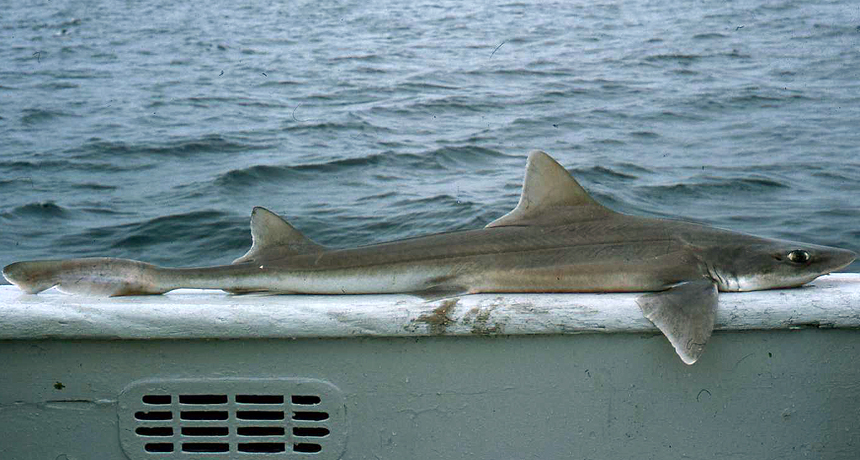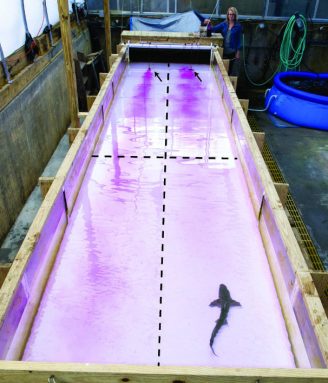Sharks’ super sniffers at risk
Increasing levels of carbon dioxide in the ocean may turn off sharks’ ability to smell prey

This shark species, called a smooth dogfish, served as a “lab rat” for scientists studying the impacts of ocean acidification on a fish’s sense of smell.
George H. Burgess, University of Florida
Sharks have such a good sense of smell that some marine scientists call them “swimming noses.” They use these finely tuned scent detectors to search out prey. But a new study shows that rising levels of carbon dioxide could erase sharks’ ability to sniff out food.
That is bad news for hungry sharks. It’s also bad news for a healthy ocean: Sharks are top predators. They keep populations of smaller marine creatures from growing out of control. They’re like the ocean’s weed controllers.
Marine biologist Danielle Dixson works at the Georgia Institute of Technology in Atlanta. She discovered the shark problem while studying the odor-tracking behavior of 24 smooth dogfish. This shark species lives off of the east coast of North America and grows to about a meter (3.3 feet) long.
The burning of fossil fuels, such as oil and gas, to drive our cars and heat our homes spews carbon dioxide into the air. Some of that gas stays in the atmosphere, helping to hold in heat from the sun. But the ocean also absorbs carbon dioxide. And that makes the water more acidic.

Dixson’s earlier work had shown that clown fish exposed to acidifying water act strangely. When they smell a predator, they swim toward it — not away. This indicated something was wrong with their sense of smell, known as olfaction. “We wanted to expand this research to sharks because we know how important it is for sharks to find their food through their sense of smell,” says Dixson.
Her team started by placing sharks in each of three different pools for five days.
Each pool had a different level of carbon dioxide dissolved in it. The first had the same amount as today’s ocean water. The second had a level of carbon dioxide that scientists expect to see by 2050 (an 83 percent increase from now). The third pool had the highest concentration of carbon dioxide (values about 163 percent higher than now). That’s a level that could develop by the year 2100.
Sharks had no access to food while in the pools. This ensured they would be hungry. Now, Dixson released the sharks — one at a time — into a pool with two side-by-side streams of flowing water.
Into one stream, the researchers pumped water in which a dead squid had been soaked overnight. This water smelled strongly of squid, something smooth dogfish love to eat. The other stream contained unscented ocean water. Because each stream flowed at the same rate and in the same direction, the squid smell stayed in its stream. The sharks could choose to swim in either stream (see photo).
Sharks that had been swimming for five days in pools of regular ocean water spent more than 60 percent of their time in the squid-scented stream. The same was true for sharks that had been in water with the carbon dioxide level that could occur by the year 2050. But sharks exposed to the highest level of carbon dioxide spent just 15 per cent of their time in the squid-scented stream.
“These sharks were actually avoiding the cues of their prey, rather than being attracted to them,” says Dixson. “We don’t know why. But we do know that this is probably going to cause problems.”
Dixson’s team published its findings online early, on August 11, in Global Change Biology.
What’s going on?
Previous research by Dixson and others has shown that as water becomes more acidic, it begins to interfere with a structure — called a receptor — on cells in a fish’s brain. The receptor works like a chemical gate. The right chemical key can unlock the gate, allowing a molecule to pass through. For this fish-brain receptor, a chemical known as GABA serves as the key. GABA unlocks the gate, allowing charged molecules (ions) to pass through the outer membrane of a cell.
Many animals, including sharks and humans, have GABA receptors. But when these receptors don’t work properly, signals can get disrupted. That appears to include the signal from the shark’s nose telling its brain there is a yummy squid ahead.
Göran Nilsson explores physiology and cell biology at the University of Oslo in Norway. There, he probes how the bodies of fish work. He says Dixson’s new research is troubling because it shows acidification doesn’t just affect smaller fish, such as clown fish.
“These sharks are very distantly related to the bony fishes that have been studied before and live in a quite different marine environment,” says Nilsson. “So apparently no fishes can feel safe in a changing future.”
Power words
acidic An adjective for materials that contain acid. These materials often are capable of eating away at some minerals such as carbonate, or preventing formation of those minerals in the first place.
acidification A process that lowers the pH of a solution. When carbon dioxide dissolves in water, it triggers chemical reactions that create carbonic acid.
carbon dioxide A colorless, odorless gas produced by all animals when the oxygen they inhale reacts with the carbon-rich foods that they’ve eaten. Carbon dioxide also is released when organic matter (including fossil fuels like oil or gas) is burned. Carbon dioxide acts as a greenhouse gas, trapping heat in Earth’s atmosphere. Plants convert carbon dioxide into oxygen during photosynthesis, the process they use to make their own food.
chemical A substance formed from two or more atoms that unite (become bonded together) in a fixed proportion and structure. For example, water is a chemical made of two hydrogen atoms bonded to one oxygen atom. Its chemical symbol is H2O.
GABA An abbreviation for gamma-aminobutyric acid. This chemical messenger acts as a brake, or inhibitor, on the firing of brain cells.
ion An atom or molecule with an electric charge due to the loss or gain of one or more electrons.
marine Having to do with the ocean world or environment.
marine biologist A scientist who studies creatures that live in ocean water, from bacteria and shellfish to kelp and whales.
molecule An electrically neutral group of atoms that represents the smallest possible amount of a chemical compound. Molecules can be made of single types of atoms or of different types. For example, the oxygen in the air is made of two oxygen atoms (O2), but water is made of two hydrogen atoms and one oxygen atom (H2O).
olfaction The sense of smell.
predator An animal that lives by killing and eating other animals.
prey Animal species eaten by others.
receptor (in biology) A molecule in cells that serves as a docking station for another molecule. That second molecule can turn on some special activity by the cell.
shark A type of predatory fish that has survived in one form or other for hundreds of millions of years. Cartilage, not bone, gives its body structure.







